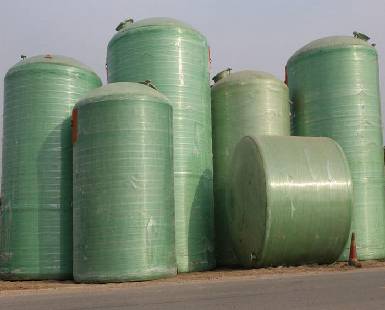News
FRP storage tank is a kind of FRP products, which is mainly a new type of composite material made by Fiberglassas a reinforcing agent and resin as a binder through a microcomputer controlled machine. FRP storage tanks are corrosion-resistant, high-strength, light-weight, and long-life. Because of their flexible design and strong manufacturability, they can be flexibly designed and used in different industries such as chemical, environmental protection, food, pharmaceuticals, etc. In the industry, it is gradually replacing most of the market areas of carbon steel and stainless steel.
The relative density is between 1.5 and 2.0, which is only 1/4 to 1/5 of carbon steel, but the tensile strength is close to or even higher than that of carbon steel, and the specific strength can be compared with high-grade alloy steel. Therefore, it has excellent results in aviation, rockets, space vehicles, high-pressure vessels, and other products that need to reduce their own weight. The tensile, bending and compressive strengths of some epoxy FRP can reach more than 400Mpa.
FRP is a good corrosion-resistant material, and it has relatively resistance to atmosphere, water and general concentrations of acids, alkalis, salts, and a variety of oils and solvents. It has been applied to all aspects of chemical corrosion protection, and is replacing carbon steel, stainless steel, wood, non-ferrous metals, etc.
It is an excellent insulating material used to make insulators. It can still protect good dielectric properties under high frequency. It has good microwave permeability and has been widely used in radomes.
FRP has low thermal conductivity, 1.25~1.67kJ/(m·h·K) at room temperature, which is only 1/100~1/1000 of that of metal. It is an excellent thermal insulation material. It is an ideal thermal protection and ablation resistant material in the instantaneous ultra-high temperature situation, and can protect the spacecraft from the erosion of high-speed airflow above 2000 ℃.
① Various structural products can be flexibly designed according to needs to meet the requirements of use, and the products can have a good integrity.
②Materials can be fully selected to meet the performance of the product, such as: corrosion resistance, instantaneous high temperature resistance, high strength in a certain direction of the product, and good dielectric properties can be designed.

FRP Storage Tank
①The molding process can be flexibly selected according to the shape, technical requirements, use and quantity of the product.
②The process is simple, it can be formed at one time, and the economic effect is outstanding, especially for products with complex shapes and small quantities that are not easy to form, and its process superiority is more prominent.
Due to the flexibility of FRP storage tank design and excellent tank wall structure performance, fiber-wound FRP can change the resin system or reinforcement materials to improve the physical and chemical properties of high-speed FRP storage tanks and non-standard equipment to meet the needs of different media and working conditions. The load-bearing capacity of the tank can be adjusted through the thickness of the structural layer, the winding angle and the wall thickness structure and the design to make FRP storage tanks and non-standard devices with different pressure levels or some special properties. This is because isotropic metal materials cannot be compared with Compared to.
(1) Inner layer: consists of a resin-rich layer and an intermediate layer. The resin-rich layer is reinforced by lining resin and organic fiber polyester felt. The resin content is more than 90%, and its thickness is about 015mm. The layer has good air-tightness and is very smooth. It mainly provides corrosion resistance and anti-permeability of the product. The middle layer is composed of lining resin and non-alkali glass fiber jet yarn. The resin content is 70%~80% and the thickness is about 2mm. The main function of this layer is to protect the resin-rich layer and improve the resistance to internal pressure failure of the inner layer. Prevent crack propagation.
(2) Structural layer: Reinforcement layer, using non-twisted glass fiber roving, reinforced by glass fabric (or chopped fiber mat), bearing tensile stress, compressive stress and various external loads, and protecting the inner layer. The resin content is 30%~40%, and its thickness is calculated and determined according to the load conditions. Adding an appropriate amount of filler to the resin can improve the wear resistance of FRP.
(3) Outer layer: also called the outer resin-rich layer, the resin content is greater than 90%, and the thickness is about 115mm. Reinforced by glass fiber surface mat, sometimes 011~012mm thin glass tape can be used to reinforce, and UV absorber is added to the resin to prevent aging. This layer mainly protects the outer wall from external mechanical damage and UV protection.